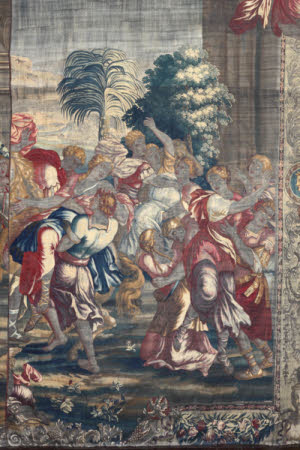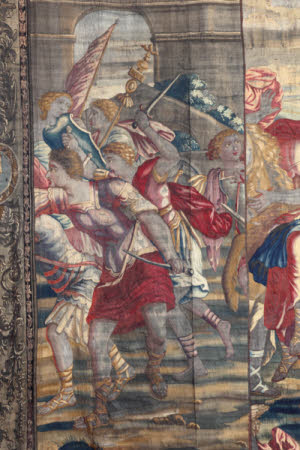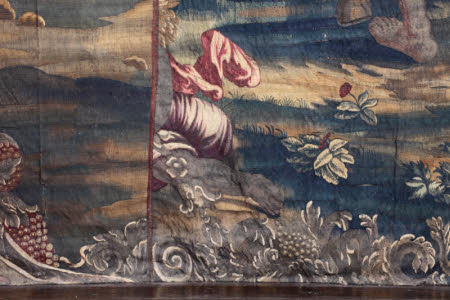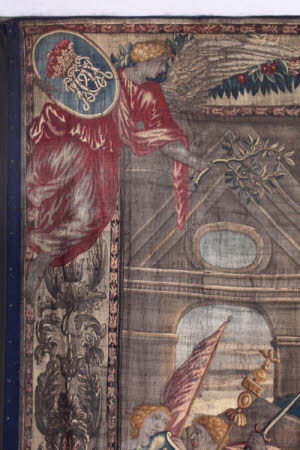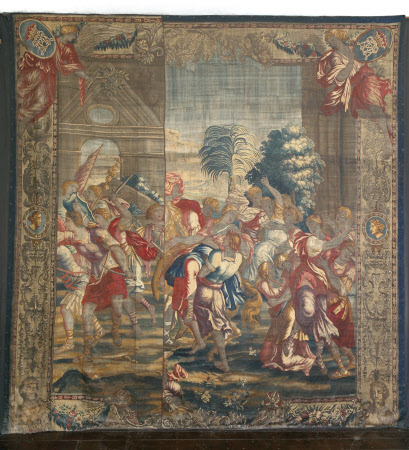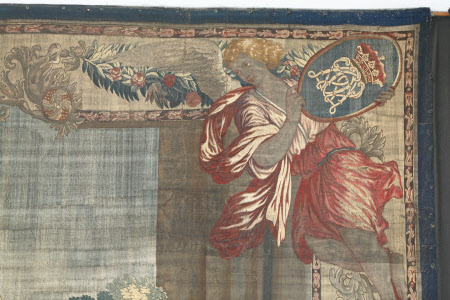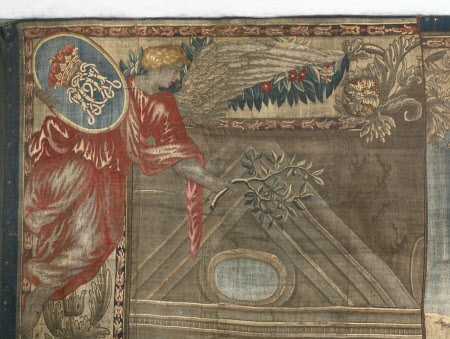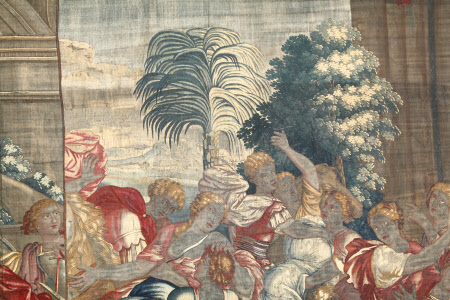The Retreat to the Palatine Gate and the Abduction of the Sabines
probably French
Category
Tapestries
Date
circa 1694 - circa 1707
Materials
Tapestry, wool and silk, 7 warps per cm
Measurements
412 x 406 cm; 430 cm (Height); 448 cm (Width)
Place of origin
France
Order this imageCollection
Hardwick Hall, Derbyshire
NT 1129463.3
Summary
Tapestry, wool and silk, 7 warps per cm, The Retreat to the Palatine Gate and the Abduction of the Sabines, from a set of three of the History of the Sabines, probably French, after a design probably by Claude Bosquet, c. 1694-1707. This piece consists of two tapestries with different scenes that have been sewn together. On the left is a narrow vertical scene, clearly part of a larger design, probably representing the ‘Retreat to the Palatine Gate’. In the foreground a number of soldiers moving in a generally right to left direction. The soldier in the foreground wears a red tunic and a purple cuirass and carries a curved sword in his left hand. Behind this soldier another, dressed in a blue/white tunic and red cloak, waves a blue and white pennant in his left hand and carries a shield. Behind this last and to his left a soldier carries a pinkish flag. Another carries a military standard. Two soldiers are looking back to where the fore-leg of a horse can just be seen centre right. In the background there is a structure with a pediment and a vista through an open archway. The larger, right-hand scene shows the ‘Abduction of the Sabine Women’. In what could be described as a chaotic scene, terrified women can be seen being forcibly taken and carried off in the arms of men whilst others attempt to fend off their attackers. To the left a man carries of a woman in his arms and at lower centre another woman falls to her knees as she attempts to fend off her abductor. Ten faces can be counted of which five appear to be men and five women. In the background on the right is a structure with three columns. The upper background shows two trees in full foliage and beyond these a view into the distance where on the left there is what appears to be some form of man-made structure, perhaps a distant village or town. The tapestry has stone coloured borders with arabesque patterns, angels at the upper corners carrying plaques bearing the monogram of the Duke of Devonshire, roundels with profile heads at the centre of each side, sphinxes at the lower corners and swags of leaves and fruit at the top and bottom. The angel at the top left carries an olive branch, emblem of peace. Although the two scenes are incomplete the edges of borders are visible at the join in the centre, indicating that the tapestries were woven with the main scenes as they now appear, probably from more extensive cartoons.
Full description
The left hand of the two scenes in the tapestry may represent ‘The Retreat to the Palatine Gate’, making it the third of four scenes from the ‘History of the Sabines’ at Hardwick. The Romans attempted to re-take the citadel on the Capitoline Hill from the Sabines, and they were met with fierce resistance. The Sabine frontline was led by Mettius Curtius and the Roman frontline by Hostius Hostilius. Hostilius was slain during the ensuing battle. According to Plutarch, at around the same time that Hostilius met his death Romulus was hit by a stone. The fall of Hostilius and the injury to Romulus caused panic to spread among the Romans and carrying Romulus they fled in retreat to the Palatine Gate with Mettius Curtius and the Sabines in hot pursuit. The Romans were chased right up to the Palatine Gate itself when Romulus, recovered from his injury, rallied his soldiers and launched a counter attack during which Mettius Curtius’s horse became bogged down in a morass and Mettius himself was fortunate to escape the battlefield with his life. It may well be that the chase to the Palatine Gate is the subject of the partial section of tapestry in the Duke’s Room at Hardwick, the background structure being the Palatine Gate. In this case, the rider of the unseen horse would be Mettius Curtius. It is likely that the soldiers depicted are Sabines in pursuit of the retreating Romans. The sword which the soldier in the fore-ground carries may be a kopsis, a curved sword used by Spartans as a secondary weapon for hacking down opponents. The right hand scene is easier to identify, and clearly depicts ‘The Abduction of the Sabine Women’. This is the first scene from the ‘History of the Sabines’ at Hardwick. According to Livy’s account, Romulus was acutely aware of the fledgling Rome’s shortage of young woman to become wives, a situation that was blamed on the unwillingness of Rome’s neighbours to allow inter-marriage. His efforts to secure treaties allowing inter-marriage with neighbouring states were rejected. He decided to hold a ‘Consualia’, a festival in honour of ‘Equestrian Neptune’, and he invited those from neighbouring states to attend (Livy, History of Rome, 1:9). Plutarch tells us that this happened on the 18th day of the month of Sextilis [August] and modern historians date the event to c.750 BC (Plutarch, Life of Romulus). The crowds assembled for the festivities. Romulus had armed his men and at a given signal they set upon the gathering and “ravished away the daughters of the Sabines.” Livy simply states that they took all the young women each being the prize of whosoever took her. Romulus gave a speech in which he blamed the whole event on their fathers for having refused his offers of inter-marriage treaties and he encouraged the women to accept their new station in life as wives of Romans. Plutarch noted that it was in memory of the abduction of the Sabine women that the practice emerged of carrying newly married brides over the thresholds of their husbands’ houses. The three ‘Sabines’ tapestries at Hardwick were long thought to represent the ‘History of Alexander’, and their place of production was uncertain. Their true subject was recently identified thanks to the swan-crested helmets and red cloaks of some of the soldiers, which according to ancient sources were worn by the Sabines to denote their Spartan heritage. This identification was confirmed by the discovery of two painted silk hangings which have similar borders to the tapestries at Hardwick, and which also show scenes from the History of the Sabines. The silk hangings were made for Louis XIV and may have served as models for the tapestries, making it probable that the tapestries were woven in France. The tapestries must have been commissioned by or for William Cavendish, 1st Duke of Devonshire (1641-1707), as they are woven with his arms, and are thus a rare example of French tapestries being commissioned by an English patron at a time when the two countries were in conflict. Research is still underway on the identity of the painter who designed the series, and the circumstances in which the tapestries were commissioned. The three tapestries at Hardwick include four scenes from the ‘History of the Sabines’: ‘The Abduction of the Sabines’ and ‘The Retreat to the Palatine Gate’ sewn together as one tapestry (1129463.3), ‘Titus Tatius Attacking the Citadel’ (1129463.2), and ‘The Reconciliation of Romulus and Titus Tatius’ (1129463.1). The main ancient sources for the story of the Sabines are Plutarch’s ‘Life of Romulus’ and Livy’s ‘Early History of Rome’. The first event represented in the tapestries, the ‘Abduction of the Sabines’, is traditionally dated to 18 August, 750 BC, and, according to Fabrius, took place four months after the completion of the building of Rome. Following the establishment of Rome, a lack of brides for the men of the city forced the Roman ruler Romulus to seek inter-marriage treaties with neighbouring tribes. These tribes, including the Sabines, considered themselves to be descendants of Lacedaemonians, more commonly known as Spartans. Romulus’ overtures were scornfully rejected leading him to adopt a more cunning and violent method of acquiring brides for the men of his city. Romulus announced that he had discovered an altar to a local underground god named either as the Equestrian Neptune or as Consus, a god of secret counsel after whom later ‘consules’ or counsellors were named. To celebrate his discovery Romulus presided over a special day of sacrifice, public games and entertainments, to which he invited people from the surrounding region to attend. At a given point during the proceedings, Romulus threw his purple cloak over his body. This was a signal for his men to draw their swords and abduct the Sabine women. This scene became a popular one for artists and tapestry makers and is represented both on a portion of a composite tapestry in the Duke’s Room at Hardwick Hall (1129463.3) and is also the subject of one of two painted silk hangings that are related to the tapestries (see below). The abduction of the Sabine Women led to a series of wars the first of which was fought between Romulus and Acron, King of the Ceninenses, whom Romulus challenged to a duel. After killing Acron in single combat, the two armies fought a battle which resulted in victory for Romulus followed by the first ever Roman Triumph. A second war ensued between Romulus and the leaders of the Crustumini, the Antemnates, and the Fidenae, who jointly attacked Romulus but were defeated leading to Romulus’ second Roman Triumph. It is possible that the second painted silk hanging (see below) depicts the meeting of Romulus and Acron. The remaining Sabine leaders looked to Titus Tatius, the Sabine King of Cures, to champion the Sabine cause, and his successful attack on the Capitoline Hill citadel is almost certainly the theme of no. 1129463.2. The left hand part of the composite tapestry, no. 1129463.3, very probably represents the aftermath of a fierce battle between the Romans and Sabines between the Capitoline and Palatine hills, when Mettius Curtius chased the retreating Romans to the Palatine Gate. After a long period of fighting the war between Romulus and the Sabines was brought to an end with the famous intervention of the Sabine woman and their children who, it is said, walked onto the battleground and placed themselves between the opposing armies pleading with their fathers, brothers, uncles, husbands and in-laws to stop fighting each other. This in turn led to the reconciliation between Romulus and Titus Tatius which is the theme of the large tapestry on the half-landing at Hardwick Hall (1129463.1). Romulus and Titus Tatius agreed to rule Rome jointly and it is from this point in their history that the Romans and Sabines considered themselves to be a single people. The intervention of the Sabine women and their children brought a dramatic end to the conflict between Romulus and the Sabines. Again, this proved to be a popular theme for artists and tapestry makers. The surviving tapestries at Hardwick Hall do not include a depiction of this scene but the complete set may originally have done so. Other scenes which may have once formed part of a ‘Sabine’ series of tapestries possibly included a depiction of the fate of Tarpeia, the death of Hostus Hostilius and, possibly, the battlefield escape of Mettius Curtius. The designs of the four tapestries at Hardwick can be linked to two late seventeenth-century painted silk hangings which recently surfaced in an English private collection. The painted hangings show different scenes to the tapestries, however their subjects are also drawn from the History of the Sabines. The painted silks share with the Hardwick tapestries the same distinctive borders with Caesars’ heads and sphinxes at the sides, angels at the upper corners, and putti playing at the bottom centre. These borders do not appear on any other known tapestries or hangings. One of the painted silks clearly shows the ‘Abduction of the Sabine Women’, a subject also included in the tapestries at Hardwick, but the design is different. The second silk hanging shows a triumphal procession of soldiers on foot and horseback, and may represent the Roman army after one of their victories over the Sabines. Whereas the Hardwick tapestries are woven with the arms and devices of William Cavendish, 1st Duke of Devonshire, the painted silks carry instead the French Royal arms and entwined letters ‘L’ (for Louis) in Greek and Latin, indicating French a royal commission. The painted silks are each signed ‘Bosquet inventor’ at the upper edge of the lower border. These features allow them to be identified with a set of four painted silks of the history of the Sabines by ‘Bosquet’ that appear in the inventory of Louis XIV at the Château du Val, near Saint-Germain, in 1672. The inventory entry reads as follows: “576 – Une petite tenture de tapisserie de peinture sur une estoffe de soye blanche à gros grains, faite à Marseilles par le Sr Bosquet, représentant l’Histoire des Sabines, contenant 17 aunes de cours, sur 3 aunes de hault, en quatre pieces doublés de toille blanche.” [A small suite of tapestries painted on coarse silk cloth, made in Marseilles by Mr Bosquet, representing the History of the Sabines, 17 ells in length by 3 ells in height, in four pieces lined with white canvas] (Guiffrey 1885-6, vol. 2, p. 286). The identity of the ‘Bosquet’ who signed the two painted silk, and who is mentioned in the 1672 inventory, is open to question as no forename is given in either source. He may be identical with an artist named ‘Du Bosquet’ who was paid 6,000 livres in 1677 for a portrait of Louis XIV and a number of other works, which may have included the painted silks (Chastagnol and Vittet 2013, p. 69). Three separate artists named Bosquet are recorded in the period, all of whom were active in Provence in southern France. A Clair Bosquet was living in Toulon in 1646, however no works are known by him (Alauzen 2006, p. 78). A painter named Jean Bosquet, from Moustiers, was recorded in Aix-en-Provence in 1665 and 1666, but again no works by him are recorded (Meissner 1992, p. 464; Boyer 1971, p. 91). Finally, a Claude Bosquet was active in Marseilles and Le Var from the 1660s to the 1680s. In 1663 he painted a ‘Presentation of the Virgin’ for a church in the village of La Penne sur Huveaune; in 1666 an ‘Assumption’ for the church of Cuers; and in 1684 the City of Marseilles commissioned from him a now lost portrait of the King. In 1682 he acted as a guarantor for the painter Michel Serre (1658-1733), who had arrived in Marseilles to paint murals at the Convent of the Minimes without being a member of the city’s guild (Homet 1987, pp. 56, 166, 180 n. 53, 187). One painting by Claude Bosquet survives: the ‘Presentation of the Virgin’, which remains in the Church of Saint-Laurent, La-Penne-sur-Huveaune, a small village to the east of Marseilles. The painting is signed ‘Bosquet inventor 1663’ – using the same slightly unusual form of words as the signatures on the two painted silk hangings of the Sabines, which also read ‘Bosquet inventor’. Stylistic features also suggest that the La Penne painting and the painted hangings could be by the same hand, allowing a tentative attribution of the painted silks, and thus potentially the design of the Hardwick tapestries, to Claude Bosquet. The relationship between the painted silks made for Louis XIV and the Hardwick tapestries is not entirely clear, but since they have the same borders (which are not known to appear anywhere else), and share a common subject of the History of the Sabines, it is probable that all six scenes are part of a single design series. One possible scenario is that the Hardwick tapestries were woven using the painted silks as models or cartoons; this is quite possible since both paintings and tapestries are roughly the same height. All three tapestries bear the arms and monograms of William Cavendish, 1st Duke of Devonshire (1641-1707) allowing them to be dated to between 1694, when he was created Duke, and 1707, when he died. Since the painted silks were in the French Royal collection until at least the 1720s (information kindly supplied by Jean Vittet), the tapestries were very probably woven in France. The principal French workshop in the period was the Manufacture Royale des Gobelins in Paris, established as a Royal manufactory in 1667 by incorporating existing Parisian workshops. The Gobelins worked principally for the King, although commissions were executed for other prominent clients. It is unlikely that the Hardwick tapestries were an official product of the Gobelins as they are not signed. However the workshops there are known to have woven unofficial works as well. Moreover, the Gobelins was officially closed from 1694-1699 due to restricted crown finances resulting from European military campaigns, and in this period production continued, but the works were often unsigned. In addition to the Gobelins, other small workshops were operating in Paris between 1694 and 1707, some of them manned by ex-Gobelins weavers, and one of these could have been responsible for the Hardwick tapestries. As noted above the tapestries bear the arms and personal devices of William Cavendish, 1st Duke of Devonshire (1641-1707). His coat of arms, complete with Ducal coronet and Garter, and the Cavendish motto ‘Cavendo Tutus’ (safety through caution) appear at the top centre of each tapestry. The angels at the upper corners carry plaques bearing his monogram, ‘WDD’ for William, Duke of Devonshire, also crowned with a Ducal coronet, and the Cavendish crest of an entwined serpent appears in a roundel at the bottom centre, again crowned with the Ducal coronet. Less easy to explain are the pairs of putti playing with leopards directly above the roundels. In the painted silks the boys are playing with a lion, probably a reference to frequent comparisons of King Louis XIV with a lion. It is possible that the replacement of a lion with a leopard in the Duke of Devonshire’s tapestries was related to his membership of a drinking club called the Honourable Order of Little Bedlam, founded by the Earl of Exeter in 1684, which met at Burghley House. Each member of the club was known by the name of an animal, and the Duke of Devonshire was The Leopard (RCHM 1876, p. 399). In his ‘Handbook of Chatsworth and Hardwick’ (1844), the 6th Duke of Devonshire’s notes that: “The tapestry on the lower staircase came from Chatsworth: that with arms and ducal coronets hung in the Leicester apartments there” (Cavendish 1844, p. 187). This almost certainly refers to the ‘Sabines’ which is the only set now at Hardwick (or indeed Chatsworth) to have arms and ducal coronets. (Helen Wyld and Terry Kilburn, 2013)
Provenance
Made for William Cavendish, 1st Duke of Devonshire (1641-1707) between 1694 and 1707; thence by descent to Andrew, 11th Duke of Devonshire (1920-2004); acquired through the National Land Fund in 1956 and transferred to the National Trust in 1959.
Credit line
Hardwick Hall, The Devonshire Collection (acquired through the National Land Fund and transferred to The National Trust in 1959)
Marks and inscriptions
On garter surrounding coat of arms, top centre: HONI SOIT QUI MAL Y PENSE On bannaret below coat of arms, top centre: CAVEN / DO / TUTUS On plaques held by angels, top left and top right: monogram ‘WDD’ (for William, Duke of Devonshire) On tablet at top of military standard, left hand scene: SPQR (in reverse)
Makers and roles
probably French , workshop probably Claude Bosquet, artist
References
Chastagnol and Vittet, 2013: Karen Chastagnol and Jean Vittet, ‘Les Portraits peints de Louis XIV au tempts de Colbert (1663-1681)’, Versalia, no. 16 (2013), pp. 53-70 Vittet, 2010: Jean Vittet and Arnauld Brejon de Lavergnée, La Collection de Tapisseries de Louis XIV, Dijon 2010 Alauzen, 2006: André Alauzen Dictionnaire des Peintres et Sculpteurs de Provence, Alpes, Côte d’Azur, Marseille 2006 Sélincourt, 2002: Livy (trans. Aubrey de Sélincourt), The Early History of Rome, Books I – V, Penquin Classics, London 2002 Clough, 2001: A.E. Clough (Ed), Plutarch’s Lives, New York 2001 Homet, 1987: Marie-Claude Homet, Michel Serre et la peinture baroque en Provence, Aix-en-Provence 1987 Boyer, 1971: Jean Boyer, ‘La Peinture et la Gravure à Aix-en-Provence au XVIe, XVIIe, et XVIIIe siècles (1530-1790), Gazette des Beaux-Arts, vol. LXXVIII (1971), pp. 3-186 Guiffrey, 1885-6: Jules Guiffrey, Inventaire général du mobilier de la couronne sous Louis XIV (1663-1715), 2 vols., Paris 1885-6 RCHM 1876: Fifth Report of the Royal Commission on Historical Manuscripts: Part I. Report and Appendix, London 1876 Cavendish, 1844: William George Spencer Cavendish, 6th Duke of Devonshire, Handbook of Chatsworth and Hardwick, privately printed, London 1844

